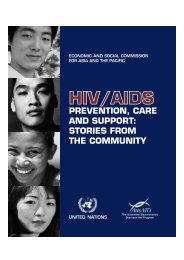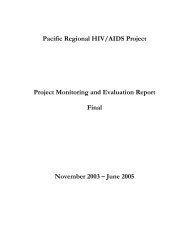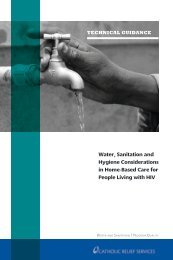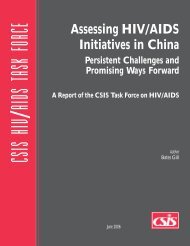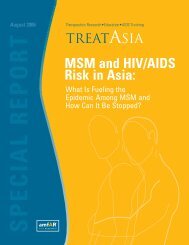Behavior Change Communication (BCC) for HIV/AIDS - hivpolicy.org
Behavior Change Communication (BCC) for HIV/AIDS - hivpolicy.org
Behavior Change Communication (BCC) for HIV/AIDS - hivpolicy.org
Create successful ePaper yourself
Turn your PDF publications into a flip-book with our unique Google optimized e-Paper software.
BEHAVIOR CHANGE COMMUNICATION (<strong>BCC</strong>)<br />
FOR <strong>HIV</strong>/<strong>AIDS</strong><br />
A STRATEGIC FRAMEWORK
This work was supported by the United States Agency <strong>for</strong> International Development (USAID) as part of Family<br />
Health International’s Implementing <strong>AIDS</strong> Prevention and Care (IMPACT) Project (Cooperative Agreement<br />
HRN-A-00-97-00017-00) and does not necessarily reflect the views of USAID or FHI.<br />
FHI implements the USAID IMPACT Project in partnership with the Institute of Tropical Medicine Management<br />
Sciences <strong>for</strong> Health • Population Services International • Program <strong>for</strong> Appropriate Technology in Health • and the<br />
University of North Carolina at Chapel Hill<br />
© September 2002<br />
Family Health International<br />
Institute <strong>for</strong> <strong>HIV</strong>/<strong>AIDS</strong><br />
2101 Wilson Boulevard, Suite 700<br />
Arlington, VA 22201 U.S.A.
BEHAVIOR CHANGE COMMUNICATION (<strong>BCC</strong>)<br />
FOR <strong>HIV</strong>/<strong>AIDS</strong><br />
A STRATEGIC FRAMEWORK<br />
GLOSSARY 3<br />
I. INTRODUCTION 5<br />
II. THE ROLE OF BEHAVIOR CHANGE COMMUNICATION 5<br />
III.<br />
THE PROCESS OF BEHAVIOR CHANGE: A FRAMEWORK<br />
FOR <strong>BCC</strong> DESIGN 7<br />
IV. <strong>BCC</strong> GOALS 8<br />
V. GUIDING PRINCIPLES 8<br />
VI. FHI’s APPROACH 9<br />
VII. <strong>BCC</strong> STRATEGY DEVELOPMENT AND PLANNING 9<br />
State program goals<br />
Involve stakeholders<br />
Identify target populations<br />
Conduct <strong>for</strong>mative <strong>BCC</strong> assessments<br />
Segment target populations<br />
Define behavior change objectives<br />
Design <strong>BCC</strong> strategy and monitoring and evaluation (M&E) plan<br />
Develop communication products<br />
Pre-testing<br />
Implement and monitor<br />
Evaluation<br />
Feedback and redesign<br />
VIII. CHALLENGES 19<br />
IX. MANAGEMENT OF <strong>BCC</strong> AND BUDGET 19<br />
X. CAPACITY-BUILDING 20<br />
XI. LINKAGES AND PARTNERSHIPS 20<br />
XII. CONCLUSION 21<br />
XIII. FURTHER READING 21<br />
1
GLOSSARY<br />
BEHAVIOR CHANGE INTERVENTION (BCI): A combination of activities/interventions tailored to<br />
the needs of a specific group and developed with that group to help reduce risk behaviors and vulnerability to<br />
<strong>HIV</strong> by creating an enabling environment <strong>for</strong> individual and collective change.<br />
BEHAVIOR CHANGE COMMUNICATION (<strong>BCC</strong>): An interactive process with communities (as<br />
integrated with an overall program) to develop tailored messages and approaches using a variety of<br />
communication channels to develop positive behaviors; promote and sustain individual, community and<br />
societal behavior change; and maintain appropriate behaviors.<br />
FORMATIVE <strong>BCC</strong> ASSESSMENT: Research conducted be<strong>for</strong>e the start of a project to help staff<br />
establish target population profiles to be used in developing messages.<br />
GATEKEEPER: A person outside a target audience who has both influence and control over access to that<br />
audience.<br />
GOAL: The hoped-<strong>for</strong> result of a program or project.<br />
INTRAVENOUS DRUG USER (IDU): A person who injects drugs (and thereby raises his or her risk of<br />
<strong>HIV</strong> infection).<br />
INFORMATION, EDUCATION AND COMMUNICATION (IEC): Development of communication<br />
strategies and support materials, based on <strong>for</strong>mative research and targeted at influencing behaviors among<br />
specific groups.<br />
OBJECTIVE: A specific, measurable and time-bound result.<br />
OPINION LEADER: A person who has great influence over members of a target audience.<br />
PLHA: Person/s living with <strong>HIV</strong>/<strong>AIDS</strong>.<br />
STRATEGIC PLANNING: A disciplined ef<strong>for</strong>t to generate fundamental decisions and actions that will<br />
shape and guide the direction of a project or program. Strategic planning is flexible, often iterative and longrange,<br />
covering a period of three to five years. It includes setting the project’s/program’s goals, strategies and<br />
objectives.<br />
STRATEGY: A coordinated and comprehensive plan <strong>for</strong> guiding multiple actions or activities that are aimed<br />
at achieving a project’s goal and objectives.<br />
STAKEHOLDER: A person or group with an interest in the outcome of an intervention.<br />
SEX WORKER (SW): A person who sells sex in exchange <strong>for</strong> money, commodities, or services.<br />
TARGET POPULATION: A group within a population who share similar characteristics and behaviors,<br />
and upon whom <strong>BCC</strong> activities are focused.<br />
TRADITIONAL MEDIA: Channels of communication that are usually culture- or community-specific.<br />
3
I. INTRODUCTION<br />
<strong>Behavior</strong> change communication (<strong>BCC</strong>) is an interactive process with communities (as integrated with an<br />
overall program) to develop tailored messages and approaches using a variety of communication channels to<br />
develop positive behaviors; promote and sustain individual, community and societal behavior change; and<br />
maintain appropriate behaviors.<br />
In the context of the <strong>AIDS</strong> epidemic, <strong>BCC</strong> is an essential part of a comprehensive program that includes<br />
both services (medical, social, psychological and spiritual) and commodities (e.g., condoms, needles and<br />
syringes). Be<strong>for</strong>e individuals and communities can reduce their level of risk or change their behaviors, they<br />
must first understand basic facts about <strong>HIV</strong> and <strong>AIDS</strong>, adopt key attitudes, learn a set of skills and be given<br />
access to appropriate products and services. They must also perceive their environment as supporting<br />
behavior change and the maintenance of safe behaviors, as well as supportive of seeking appropriate<br />
treatment <strong>for</strong> prevention, care and support.<br />
In most parts of the world, <strong>HIV</strong> is primarily a sexually transmitted infection (STI). Development of a<br />
supportive environment requires national and community-wide discussion of relationships, sex and sexuality,<br />
risk, risk settings, risk behaviors and cultural practices that may increase the likelihood of <strong>HIV</strong> transmission.<br />
A supportive environment is also one that deals, at the national and community levels, with stigma, fear and<br />
discrimination, as well as with policy and law. The same issues apply in parts of the world where unsafe<br />
injection of illegal drugs is the chief source of new infections.<br />
The <strong>AIDS</strong> epidemic <strong>for</strong>ces societies to confront cultural ideals and practices that can contribute to <strong>HIV</strong><br />
transmission. Effective <strong>BCC</strong> is vital to setting the tone <strong>for</strong> compassionate and responsible interventions. It<br />
can also produce insight into the broader socioeconomic impacts of the epidemic and mobilize the political,<br />
social and economic responses needed to mount an effective program.<br />
FHI’s pragmatic <strong>BCC</strong> approach, based on sound practice and experience, focuses on building local, regional<br />
and national capacity to develop integrated <strong>BCC</strong> that leads to positive action by stimulating society-wide<br />
discussions. <strong>BCC</strong> is both an essential component of each program area and the glue between the various<br />
areas. However, society-wide change is slow; changes achieved through <strong>BCC</strong> will not occur overnight.<br />
This document outlines FHI’s <strong>BCC</strong> strategy <strong>for</strong> <strong>HIV</strong>/<strong>AIDS</strong>. It has been developed <strong>for</strong> use by donors,<br />
partners, collaborators and potential collaborators.<br />
II. THE ROLE OF BEHAVIOR CHANGE COMMUNICATION<br />
<strong>BCC</strong> is an integral component of a comprehensive <strong>HIV</strong>/<strong>AIDS</strong> prevention, care and support program. It has<br />
a number of different but interrelated roles. Effective <strong>BCC</strong> can:<br />
• Increase knowledge. <strong>BCC</strong> can ensure that people are given the basic facts about <strong>HIV</strong> and <strong>AIDS</strong> in a<br />
language or visual medium (or any other medium that they can understand and relate to).<br />
• Stimulate community dialogue. <strong>BCC</strong> can encourage community and national discussions on the basic<br />
facts of <strong>HIV</strong>/<strong>AIDS</strong> and the underlying factors that contribute to the epidemic, such as risk behaviors<br />
and risk settings, environments and cultural practices related to sex and sexuality, and marginalized<br />
practices (such as drug use) that create these conditions. It can also stimulate discussion of healthcareseeking<br />
behaviors <strong>for</strong> prevention, care and support.<br />
5
• Promote essential attitude change. <strong>BCC</strong> can lead to appropriate attitudinal changes about, <strong>for</strong><br />
example, perceived personal risk of <strong>HIV</strong> infection, belief in the right to and responsibility <strong>for</strong> safe<br />
practices and health supporting services, compassionate and non-judgmental provision of services,<br />
greater open-mindedness concerning gender roles and increasing the basic rights of those vulnerable to<br />
and affected by <strong>HIV</strong> and <strong>AIDS</strong>.<br />
• Reduce stigma and discrimination. <strong>Communication</strong> about <strong>HIV</strong> prevention and <strong>AIDS</strong> mitigation<br />
should address stigma and discrimination and attempt to influence social responses to them (see box).<br />
• Create a demand <strong>for</strong> in<strong>for</strong>mation and services. <strong>BCC</strong> can spur individuals and communities to demand<br />
in<strong>for</strong>mation on <strong>HIV</strong>/<strong>AIDS</strong> and appropriate services.<br />
• Advocate. <strong>BCC</strong> can lead policymakers and opinion leaders toward effective approaches to the epidemic.<br />
• Promote services <strong>for</strong> prevention, care and support. <strong>BCC</strong> can promote services <strong>for</strong> STIs, intravenous<br />
drug users (IDUs), orphans and vulnerable children (OVCs); voluntary counseling and testing (VCT) <strong>for</strong><br />
mother-to-child transmission (MTCT); support groups <strong>for</strong> PLHA; clinical care <strong>for</strong> opportunistic<br />
infections; and social and economic support. <strong>BCC</strong> is also an integral component of these services.<br />
• Improve skills and sense of self-efficacy. <strong>BCC</strong> programs can focus on teaching or rein<strong>for</strong>cing new<br />
skills and behaviors, such as condom use, negotiating safer sex and safe injecting practices. It can<br />
contribute to development of a sense of confidence in making and acting on decisions.<br />
6<br />
STIGMA<br />
Stigma is a mark of shame or discredit on a person or group. Stigma can manifest itself in a variety of<br />
ways, from ignoring the needs of a person or group to psychologically or physically harming those who<br />
are stigmatized. Stigma is often felt by PLHA, men who have sex with men (MSM), sex workers (SWs),<br />
IDUs, migrant populations and others.<br />
The importance of addressing stigma in the context of <strong>BCC</strong> campaigns has programmatic implications<br />
that transcend questions of compassion and humane treatment. Failure to address stigma jeopardizes<br />
<strong>BCC</strong> programs in critical ways:<br />
Prevention. <strong>BCC</strong> programs that fail to address stigma allow some people to ignore the messages of<br />
<strong>HIV</strong> prevention. Stigma can cause people to perceive individuals with or at risk <strong>for</strong> <strong>HIV</strong> as the other<br />
(“them”), rein<strong>for</strong>cing their feeling that <strong>HIV</strong> “couldn’t happen to me.” Failure to address stigma can also<br />
deter individuals from seeking out VCT and proper medical care, including MTCT prevention services.<br />
Stigma is also sometimes attached to carrying condoms. Stigma can work against prevention programs;<br />
<strong>for</strong> example, an outreach or peer education program <strong>for</strong> MSM, IDUs, or SWs can be damaged by<br />
“round-ups” and detention of beneficiaries.<br />
Quality of care. Stigma can perpetuate harmful practices, such as discrimination against or poor<br />
treatment of PLHA, IDUs, MSM, or SWs. A <strong>BCC</strong> campaign to increase demand at a health facility<br />
would be hurt if poor quality of care were encountered there by PLHA.<br />
Policy. Programs that fail to address stigma help perpetuate discriminatory laws and practices and, in<br />
some cases, result in failure to en<strong>for</strong>ce laws against them. Such programs also miss an opportunity to<br />
influence policy direction.<br />
<strong>BCC</strong> programs that address stigma can work with and employ people from traditionally stigmatized<br />
groups, such as PLHA, SWs and MSM, as advocates <strong>for</strong> policy change. Such individuals can also serve<br />
as dedicated caregivers, social workers, peer educators and role models <strong>for</strong> change.
III. THE PROCESS OF BEHAVIOR CHANGE: A FRAMEWORK FOR <strong>BCC</strong> DESIGN<br />
<strong>BCC</strong> has its roots in behavior change theories that have evolved over the past several decades. These theories<br />
are valuable foundations <strong>for</strong> developing comprehensive communication strategies and programs. FHI’s <strong>BCC</strong><br />
practitioners draw upon various models and theories to design effective programs and activities. These<br />
include the Diffusion of Innovations model (Everett Rogers), the Stages of <strong>Change</strong> model (Prochaska,<br />
DiClemente and Norcross), the Self-Efficacy model (Bandura) and the <strong>Behavior</strong> <strong>Change</strong> Continuum (World<br />
Bank). FHI <strong>BCC</strong> practitioners use a combination of theories and practical steps that are based on field<br />
realities, rather than relying on any single theory or model. The following figure is based on the prevailing<br />
models and theories, and is one framework that guides FHI’s <strong>BCC</strong> design.<br />
Figure 1. A framework <strong>for</strong> <strong>BCC</strong> design<br />
Stages of behavior change<br />
continuum<br />
Unaware<br />
Aware<br />
Concerned<br />
Knowledgeable<br />
Motivated to change<br />
Practicing trial behavior<br />
change<br />
Practicing sustained<br />
behavior change<br />
Enabling factors<br />
Providing effective<br />
communication<br />
Creating an enabling<br />
environment--<br />
policies, community<br />
values, human rights<br />
Providing userfriendly,<br />
accessible<br />
services and<br />
commodities<br />
Channels<br />
Mass<br />
media<br />
Community<br />
networks and<br />
traditional<br />
Media<br />
Interpersonal/<br />
group<br />
communication<br />
When changing behavior, the individual, community, or institution goes through a series of steps—<br />
sometimes moving <strong>for</strong>ward, sometimes moving backward and sometimes skipping steps. Even when<br />
individuals, communities, or institutions adopt new behaviors, they may at times revert to old behaviors, at<br />
least under certain circumstances. Understanding where the majority of a group is in the change process is<br />
crucial when designing a <strong>BCC</strong> strategy.<br />
Different channels have been shown to be more effective at different stages of the continuum and <strong>for</strong><br />
achieving different goals. <strong>Communication</strong> through mass media can ensure that correct in<strong>for</strong>mation reaches a<br />
specific population and can model positive attitudes, but when an individual or community is motivated to<br />
attempt new behaviors, policies and the larger social environment become more important. When audiences<br />
become ready to change, the activities, services, or products being promoted must be available to them.<br />
7
IV. <strong>BCC</strong> GOALS<br />
<strong>Behavior</strong> change communication goals need to be developed in the context of overall program goals and<br />
specific behavior change goals. The following highlights the place of <strong>BCC</strong> goals within an overall program.<br />
Program goal: Reduce <strong>HIV</strong> prevalence among young people in urban settings in X country.<br />
<strong>Behavior</strong> change goals:<br />
• Increase condom use<br />
• Increase appropriate STI care-seeking behavior<br />
• Delay sexual debut<br />
• Reduce number of partners<br />
<strong>BCC</strong> goals:<br />
• Increase perception of risk or change attitudes toward use of condoms<br />
• Increase demand <strong>for</strong> services<br />
• Create demand <strong>for</strong> in<strong>for</strong>mation on <strong>HIV</strong> and <strong>AIDS</strong><br />
• Create demand <strong>for</strong> appropriate STI services<br />
• Interest policymakers in investing in youth-friendly VCT services (services must be in place)<br />
• Promote acceptance among communities of youth sexuality and the value of reproductive health services<br />
<strong>for</strong> youth (services must be in place)<br />
<strong>BCC</strong> goals are related to specific issues identified when assessing the situation, knowledge, attitudes and skills<br />
that may need to be changed to work toward behavior change and program goals.<br />
V. GUIDING PRINCIPLES<br />
• <strong>BCC</strong> should be integrated with program goals from the start. <strong>BCC</strong> is an essential element of <strong>HIV</strong><br />
prevention, care and support programs, providing critical linkages to other program components,<br />
including policy initiatives.<br />
• Formative <strong>BCC</strong> assessments must be conducted to improve understanding of the needs of target<br />
populations, as well as of the barriers to and supports <strong>for</strong> behavior change that their members face (along<br />
with other populations, such as stakeholders, service providers and community).<br />
• The target population should participate in all phases of <strong>BCC</strong> development and in much of<br />
implementation.<br />
• Stakeholders need to be involved from the design stage.<br />
• Having a variety of linked communication channels is more effective than relying on one specific<br />
one.<br />
• Pre-testing is essential <strong>for</strong> developing effective <strong>BCC</strong> materials.<br />
• Planning <strong>for</strong> monitoring and evaluation should be part of the design of any <strong>BCC</strong> program.<br />
8
• <strong>BCC</strong> strategies should be positive and action-oriented.<br />
• PLHA should be involved in <strong>BCC</strong> planning and implementation.<br />
VI. FHI’S APPROACH<br />
<strong>BCC</strong> is both an essential component of an <strong>HIV</strong>/<strong>AIDS</strong> program and a support element in the program’s<br />
service, mitigation and policy components. FHI develops <strong>BCC</strong> in the context of a prevention, care and<br />
support program. FHI advocates moving beyond individual communication products to an integrated<br />
use of many different interventions, products and channels, woven together into a comprehensive<br />
strategy. A <strong>BCC</strong> strategy based on sound <strong>for</strong>mative <strong>BCC</strong> assessment can ensure that communication<br />
effectively influences community discussions and social norms and plays an important role in services and<br />
individual and community behavior, once services and commodities are in place.<br />
FHI works to contribute to national program goals and collaborate with other national, regional and<br />
international partners to achieve greater impact. Linkages with other <strong>BCC</strong> in-country initiatives and programs<br />
are essential to ensure the effectiveness of FHI’s <strong>BCC</strong> initiatives.<br />
VII. <strong>BCC</strong> STRATEGY DEVELOPMENT AND PLANNING<br />
To put this approach into action, FHI promotes a practical, step-by-step methodology <strong>for</strong> developing and<br />
implementing a <strong>BCC</strong> strategy. The following steps are meant as a general guide, rather than as a blueprint.<br />
Where local situations vary, the strategy should be adapted accordingly. (It should be noted that some of<br />
these steps may take place simultaneously. For example, monitoring the involvement of stakeholders will<br />
happen throughout all steps of strategy development.)<br />
9
Figure 2. Steps in developing a behavior change communication strategy<br />
1.<br />
State program 2.<br />
goals Involve<br />
3.<br />
stakeholder<br />
Identify target 4.<br />
populations Conduct<br />
<strong>for</strong>mative <strong>BCC</strong><br />
assessments<br />
5.<br />
Segment target<br />
populations<br />
6.<br />
Define behavior change<br />
objectives<br />
12.<br />
Analyze feedback and revision<br />
7.<br />
Design <strong>BCC</strong> strategy<br />
and M & E plan<br />
11.<br />
Evaluate<br />
10.<br />
Implement and monitor<br />
9.<br />
Pre-test<br />
8.<br />
Develop<br />
communication<br />
products<br />
10
State program goals<br />
FHI’s program goals are designed in coordination with national <strong>HIV</strong> and <strong>AIDS</strong> strategies. Clearly identifying<br />
overall program goals is the first step in developing a <strong>BCC</strong> strategy. Specific FHI program goals are<br />
established after reviewing existing data, epidemiological in<strong>for</strong>mation and in-depth program situation<br />
assessments.<br />
Involve stakeholders<br />
Key stakeholders need to be involved early on in every step of the process of developing <strong>HIV</strong>/<strong>AIDS</strong><br />
programs and their <strong>BCC</strong> components. Stakeholders include policymakers, opinion leaders, community<br />
leaders, religious leaders and members of target populations, including PLHA. Their active participation at<br />
appropriate stages of <strong>BCC</strong> strategy development is essential. A stakeholders’ meeting should be held at the<br />
planning stage to obtain guidance and commitments to the process and to develop coordination mechanisms.<br />
Identify target populations<br />
To develop communication, it is important to identify the target populations as clearly as possible. Target<br />
populations are defined as primary or secondary. Primary populations are the main groups whose<br />
<strong>HIV</strong>/<strong>AIDS</strong>-related behavior the program is intended to influence. Secondary populations are those groups<br />
that influence the ability of the primary population to adopt or maintain appropriate behaviors. For example,<br />
an <strong>HIV</strong> program may seek to increase condom use among sex workers and clients (primary populations). But<br />
to achieve this objective, it may be necessary to change the behavior or gain the support of brothel owners<br />
and police (secondary populations).<br />
Target populations include:<br />
• Individuals at high risk or vulnerability, such as sex workers, their clients, youth, migrant workers,<br />
IDUs, or uni<strong>for</strong>med services personnel<br />
• People providing services, such as health workers, private practitioners, pharmacists, counselors and<br />
social service workers<br />
• Policymakers, such as politicians<br />
• Leaders and authorities, <strong>for</strong>mal and in<strong>for</strong>mal, including law-en<strong>for</strong>cement, social and religious leaders<br />
• Local communities and families<br />
Conduct <strong>for</strong>mative <strong>BCC</strong> assessments<br />
A <strong>for</strong>mative <strong>BCC</strong> assessment should start by seeking out all available studies, including data from in-depth<br />
assessments or rapid ethnographic assessments, behavioral surveillance surveys and other related studies.<br />
After synthesizing this in<strong>for</strong>mation, a <strong>for</strong>mative <strong>BCC</strong> assessment protocol can be developed. The <strong>for</strong>mative<br />
<strong>BCC</strong> assessment should collect in<strong>for</strong>mation on:<br />
• Risk situations, showing in detail how decisions are made in different situations, including what<br />
influences the decisions and settings <strong>for</strong> risk<br />
• Why individuals and groups practice the behaviors they do, and why they might be motivated to change<br />
(or unable to change) to the desired behaviors<br />
• Perceptions of risk and risk behaviors<br />
• Influences on behavior, such as barriers or benefits<br />
• Insights of opinion leaders<br />
• Patterns of service use and opinions about these services<br />
11
• Perceptions of stigma and discrimination<br />
• Future hopes, fears and goals<br />
• Media and entertainment habits<br />
• Health care-seeking behaviors<br />
• Positive deviants, or those most willing to model change<br />
• Media resources<br />
Formative <strong>BCC</strong> assessments make use of qualitative methods, such as focus group discussions, key in<strong>for</strong>mant<br />
interviews, direct observation, participatory learning methods, rapid ethnographic assessments, mapping and<br />
in-depth interviews. Where possible, the <strong>org</strong>anizations that are directly engaged with the population, such as<br />
community-based and non-governmental groups, should participate in the <strong>for</strong>mative <strong>BCC</strong> assessment with<br />
assistance from appropriate research institutions.<br />
Segment target populations<br />
Based on the <strong>for</strong>mative <strong>BCC</strong> assessment, target populations can then be segmented. For example, sex<br />
workers can be grouped more specifically according to work location (street, home, brothel), income level,<br />
ethnicity, or language.<br />
Population segments are often defined by psychosocial and demographic characteristics. Psychosocial<br />
characteristics include the knowledge, attitudes and practices typically demonstrated by a given group or<br />
audience; or by their role in society, their <strong>for</strong>mal and in<strong>for</strong>mal responsibilities and their level of authority.<br />
Demographic characteristics include age, place of residence (or work), place of birth, religion and ethnicity. In<br />
addition, structural factors and settings (e.g., in the workplace, risk settings, border settings) should also be<br />
considered. For example, if sex workers and truck drivers are the target population, border crossings and<br />
truck stops constitute risk settings.<br />
Define behavior change objectives<br />
Whether the target population is a particular group or the general public, it is important first to refer to the<br />
<strong>HIV</strong>/<strong>AIDS</strong> program behavior change objectives. What changes in behavior does the program intend to<br />
achieve? While behavior changes may not have been specified in project documents, they can be inferred<br />
from project goals. Following are some common behavior change objectives:<br />
• Increased safer sexual practices (more frequent condom use, fewer partners)<br />
• Increased incidence of healthcare-seeking behavior <strong>for</strong> STIs, TB and VCT (<strong>for</strong> example, calls or visits to<br />
facilities)<br />
• Increased use of universal precautions to improve blood safety<br />
• Increased blood donations (where appropriate)<br />
• Improved compliance with drug treatment regimens<br />
• Adherence by medical practitioners to treatment guidelines<br />
• Increased use of new or disinfected syringes and needles by IDUs<br />
• Decline in stigma associated with <strong>HIV</strong>/<strong>AIDS</strong><br />
• Reduced incidence of discriminatory activity directed at PLHA and other identified high- risk groups<br />
• Improved attitudes and behavior among healthcare, social service and other service delivery workers who<br />
interact with PLHA, SWs, IDUs and other marginalized groups<br />
12
• Increased involvement of opinion leaders and policymakers, private sector managers and community<br />
members<br />
• Increased involvement in self-help and homecare initiatives<br />
Design <strong>BCC</strong> strategy and Monitoring and Evaluation (M&E) Plan<br />
A <strong>BCC</strong> strategy is best designed in a participatory fashion, including members of target populations,<br />
<strong>org</strong>anizations planning to work with them and stakeholders. Designing a <strong>BCC</strong> strategy is more than a matter<br />
of developing messages and media materials <strong>for</strong> dissemination. It is necessary to find the right mix of<br />
approaches to involve target populations—that is, to get their attention—and to promote and enable action.<br />
A well-designed <strong>BCC</strong> strategy should include:<br />
• Clearly defined <strong>BCC</strong> objectives<br />
• An overall concept or theme and key messages<br />
• Identification of channels of dissemination<br />
• Identification of partners <strong>for</strong> implementation (including capacity-building plan)<br />
• A monitoring and evaluation plan<br />
Taking each target population’s needs and situation into consideration, along with the initiatives that answer<br />
those needs, a theme and key messages must be developed to provide a framework around which focused<br />
communication activities can be planned. Ideally, well-tested messages developed with the participation of<br />
target populations are disseminated through a variety of channels—mass media, interpersonal<br />
communication, traditional media, community-based activities and advocacy—to ensure that aspects of the<br />
in<strong>for</strong>mation received by the target populations rein<strong>for</strong>ce each other. With proper planning, <strong>BCC</strong> program<br />
implementers can build on existing quality communication and benefit from existing opportunities. Mutually<br />
rein<strong>for</strong>cing messages lend legitimacy to one another and stimulate community discussion and dialogue.<br />
Interpersonal communicators, such as peer educators, outreach workers, counselors and other service<br />
providers, need to be prepared and well in<strong>for</strong>med of both the findings of <strong>for</strong>mative research and the key<br />
messages, so that their work will support that of the campaign and vice versa. For example, to make use of<br />
research findings and the content of messages, they will need to know any internal and external barriers and<br />
enabling factors. They should be prepared to promote services and products and to deliver communication<br />
messages. They will need to know of and be prepared to build on other communication activities. For<br />
example, they will have to enure that audiences are aware of various mass communication activities and<br />
promote the discussion of messages. If mutually rein<strong>for</strong>cing messages are to be delivered and community<br />
discussion stimulated, this preparation is essential.<br />
It is also important to ensure that <strong>HIV</strong> and <strong>AIDS</strong> messages not conflict with the messages of other<br />
<strong>org</strong>anizations. For example, in many countries, public health authorities promote condoms, but religious<br />
<strong>org</strong>anizations promote fidelity and oppose condom use. It may be necessary to find ways to work around<br />
conflicting messages from other sources. It is essential to prepare community-based communication and<br />
training service workers to deal with potential conflicts.<br />
Define <strong>BCC</strong> objectives<br />
Observable changes in behavior, as specified in the behavior change objectives, are a final program outcome.<br />
Such changes are generally preceded by intermediate changes. Such changes include:<br />
13
• Knowledge change: an increase in knowledge among targeted youth of modes of transmission<br />
• Attitude change: an increase in perception of personal risk or a change in authorities’ attitudes toward<br />
promoting condoms to youth<br />
• Environmental change: a decrease in harassment of sex workers by police or an increase in acceptance<br />
of messages about condom use on television<br />
Although some of these changes are not directly related to behavior change, they can function as necessary<br />
environmental antecedents or as shifts that reflect an increasingly supportive environment.<br />
An effective <strong>BCC</strong> strategy needs to be developed to guide achievement of intermediate and longer-term<br />
outcomes. Examples of <strong>BCC</strong> objectives are:<br />
• Increased demand <strong>for</strong> in<strong>for</strong>mation about <strong>HIV</strong> and <strong>AIDS</strong>. (Youth will ask <strong>for</strong> in<strong>for</strong>mation about <strong>HIV</strong> and<br />
<strong>AIDS</strong>.)<br />
• Increased knowledge about <strong>HIV</strong> and <strong>AIDS</strong>. (Youth will have correct knowledge of modes of<br />
transmission of <strong>HIV</strong> and <strong>AIDS</strong>.)<br />
• Increased self-risk assessment. (Truck drivers will say that if they do not use condoms they feel at<br />
increased risk of contracting <strong>HIV</strong>.)<br />
• Increased demand <strong>for</strong> in<strong>for</strong>mation on STIs. (Miners will ask <strong>for</strong> more in<strong>for</strong>mation on STIs.)<br />
• Increased demand <strong>for</strong> services. (Sex workers will demand VCT services.)<br />
Develop themes and messages<br />
It is important to develop an overall theme that will appeal to and attract target populations. The theme<br />
should stem from the <strong>BCC</strong> <strong>for</strong>mative assessment and further consultation. The theme will provide overall<br />
guidance <strong>for</strong> the development of messages, all of which will there<strong>for</strong>e be consistent with the theme.<br />
The theme should be positive. It is now commonly understood that fear campaigns and campaigns blaming<br />
particular groups are ineffective. Most experts agree that fear tends to focus an audience’s attention on what<br />
not to do, or what to avoid. Approaches are more effective when they promote positive messages that state<br />
clearly what audiences can and should do.<br />
Themes should also avoid blaming or stigmatizing. Messages that blame a particular group can backfire,<br />
especially in <strong>AIDS</strong> programs, by diverting audiences’ attention from their own needed behavior changes.<br />
Such messages can also encourage discrimination, stigma and even physical harm to PLHA and other<br />
vulnerable groups. Stigma and denial can in turn cause people to avoid services that may benefit them.<br />
The theme should call attention to the campaign and link its various elements together, functioning as a sort<br />
of umbrella. It should be catchy and devised in such a way that all target populations can relate to it and<br />
identify with it. People who see different messages <strong>for</strong> different audiences should be able to link any of these<br />
diverse elements with the theme of the campaign.<br />
Effective prevention and care messages should diplomatically “push the envelope,” if necessary, and, to avoid<br />
conflict, take into account the country’s traditions, culture, norms and values.<br />
A message consists of carefully crafted in<strong>for</strong>mation that is targeted at specific population groups. It should be<br />
designed to meet <strong>BCC</strong> objectives and to stimulate discussion and action. Messages are the most critical<br />
element in developing a <strong>BCC</strong> strategy—and they are the area where most strategies fail.<br />
14
Using standard methodology, FHI works through a series of steps to develop the overall theme and key<br />
messages.<br />
Step 1. Develop a profile of the target population from <strong>for</strong>mative <strong>BCC</strong> assessment.<br />
Step 2. Identify desired behavior change.<br />
Step 3. Understand and take into account the varying situations that could affect action and decision-making.<br />
Step 4. Identify the in<strong>for</strong>mation or data that you want understood by the target population.<br />
Step 5. Develop key benefit statements that take the hopes and aspirations of the target population into<br />
account: “If I do X (use condoms, get in<strong>for</strong>mation, seek out treatment), I will benefit by Y”<br />
(remaining fertile, being seen as responsible, protecting my family, saving money, looking smart and<br />
sophisticated, attracting the opposite sex, etc.) Whatever the benefit, it will have to outweigh any<br />
disadvantages or “costs” the audiences might feel.<br />
Step 6. Develop messages from key benefit statements. Messages should be simple, attractive and make clear<br />
the benefits of what is being promoted, through words or images.<br />
Messages that promote products, such as condoms, must include in<strong>for</strong>mation on where to get those products<br />
and how to use them. If a message promotes skill development or specific services, then the services that are<br />
being promoted must actually exist.<br />
People may also need messages that help them feel they can succeed. This may be accomplished through<br />
messages that model success and positive outcomes.<br />
Choose channels<br />
A channel is the way a message is disseminated. It is important to know which channels can most effectively<br />
reach particular target populations. Identifying the range of available channels should be part of every<br />
<strong>for</strong>mative <strong>BCC</strong> assessment.<br />
Messages can be delivered through mass media—<strong>for</strong> example, television or radio spots; articles in periodicals;<br />
or material in brochures, posters, flip charts, picture codes or comics—or in-person, by health workers, peer<br />
educators, counselors, or other trained personnel. Additional means of delivery include musical or dramatic<br />
per<strong>for</strong>mances and community events. Messages can be rein<strong>for</strong>ced with “gimmicks” such as key chains or<br />
stickers.<br />
It is important to think about how particular channels can help achieve particular goals. Each medium has its<br />
own advantages and disadvantages, so that each may be best suited to a particular circumstance. For example,<br />
research has shown that mass media can raise awareness of specific facts, because the mass media are<br />
assumed to carry a certain authority and reliability. Mass media can also model behaviors and positive<br />
attitudes in the person of respected members of the target community. Later on in the process, however,<br />
target populations appear less interested in media authority than they are in the opinions and behaviors of<br />
people to whom they feel close. Interpersonal communication becomes primary, while the mass media play a<br />
supporting role.<br />
If mass media are used, it is important to know which radio stations and TV programs are popular with the<br />
target population. It may not be cost-effective to use a less expensive AM news station if the message is<br />
intended <strong>for</strong> youth who primarily listen to FM music stations.<br />
15
Peer education (or peer facilitation) is a cornerstone of all interventions with target populations. In Peer<br />
Education, Concepts, Uses and Challenges (UN<strong>AIDS</strong> 1999), a literature review was reported to have found that<br />
peer education has an overwhelmingly positive impact on STI or <strong>HIV</strong> incidence and risk behaviors. Peer<br />
educators can help reach specific groups, model safe behaviors, stimulate community discussions and provide<br />
referrals to appropriate services.<br />
In resource-constrained settings, it is especially important to look <strong>for</strong> opportunities to link various channels,<br />
taking advantage of a maximum number of opportunities. If there is a national campaign, <strong>for</strong> instance,<br />
interpersonal messages should be linked to messages in the mass media. If the chief medium chosen is radio<br />
talk shows <strong>for</strong> youth, issues related to youth and <strong>HIV</strong>/<strong>AIDS</strong> should be scheduled as discussion topics. Links<br />
should also be created to messages that promote condoms through a social-marketing campaign.<br />
Develop monitoring and evaluation plan<br />
A plan <strong>for</strong> monitoring and evaluation needs to be drawn up during the initial stage of <strong>BCC</strong> strategy design.<br />
The in<strong>for</strong>mation to be gathered <strong>for</strong> <strong>BCC</strong> should be linked to the program’s overall monitoring system.<br />
Monitoring is part of the ongoing management of communication activities, and it usually focuses on the<br />
process of implementation. The following should be closely monitored:<br />
• Reach: Are adequate numbers of the audience being reached over time?<br />
• Coordination: Are messages adequately coordinated with service and supply delivery and with other<br />
communication activities? Are communication activities taking place on schedule, at the planned<br />
frequency?<br />
• Scope: Is communication effectively integrated with the necessary range of audiences, issues and<br />
services?<br />
• Quality: What is the quality of communication (messages, media and channels)?<br />
• Feedback: Are the changing needs of target populations being captured?<br />
To monitor the course of a <strong>BCC</strong> strategy properly, it is necessary to establish effective in<strong>for</strong>mation-gathering<br />
systems. These include reports, site visits and reviews of materials. Reporting tools and protocols must be<br />
standardized to ensure consistency.<br />
Periodic focus-group discussions and in-depth interviews can also help <strong>BCC</strong> programmers assess the<br />
perceptions of target populations. Peer educators can collect responses from target populations to help<br />
identify changes that may have to be made in the environment or aspects of communication and services that<br />
may need to be addressed.<br />
The evaluation of outcomes (actual, measurable changes in behavior and environment) is generally more<br />
complex and may be beyond the resources and abilities of many country-level programs, and certainly of<br />
projects. Good monitoring data enables programs to demonstrate the degree to which they have contributed<br />
to changes as measured by national surveillance systems, such as the <strong>Behavior</strong>al Surveillance Survey (BSS).<br />
Questions related to communication intervention can be added to such a survey to assess the activities’ reach.<br />
16
Choose partners<br />
In developing a <strong>BCC</strong> strategy, it is important to identify key partners who can help design and implement its<br />
components. Partners may include NGOs, government counterparts, media outlets, graphic designers, local<br />
traditional entertainers, members of target populations and other program implementers. It is essential to plan<br />
<strong>for</strong> capacity-building of partners (see below).<br />
Develop communication products<br />
Development of specific communication support materials should be based on decisions made about<br />
channels and activities. They can include:<br />
• Print materials <strong>for</strong> peer educators, such as flip charts and picture codes<br />
• Print materials to support health workers on specific care issues<br />
• Television spots <strong>for</strong> general broadcast<br />
• Promotional materials about the project, <strong>for</strong> advocacy<br />
• Scripts <strong>for</strong> theater and street theater<br />
• Radio or television soap opera scripts<br />
Conduct pre-testing<br />
Pre-testing is key to ensuring that themes, messages and activities reach the intended target populations. It is<br />
important to pre-test at every stage with all audiences <strong>for</strong> whom the communication is intended, both primary<br />
and secondary. Pre-testing should be done of themes, messages, prototype materials, training packages,<br />
support tools and <strong>BCC</strong> <strong>for</strong>mative assessment instruments.<br />
Pre-testing of media, messages and themes should evaluate:<br />
• Comprehension<br />
• Attraction<br />
• Persuasion<br />
• Acceptability<br />
• Audience members’ degree of identification<br />
Several versions should be pre-tested and audience reactions compared.<br />
Although not as important as pre-testing with members of the target population, pre-testing and discussions<br />
should also be done with stakeholders, since their views may differ from those of the target population. This<br />
is not always possible, but with an eye toward minimizing controversy, programmers should attempt it, since<br />
disagreement with stakeholders can derail or compromise a program.<br />
Implement and monitor<br />
In the implementation phase, all elements of the strategy go into operation. An especially important element<br />
is management. All partners, programmers and channels of the <strong>BCC</strong> strategy must be closely coordinated.<br />
There must be links among critical program elements, such as supply and demand. If populations discover<br />
that VCT services being promoted by <strong>BCC</strong> messages and materials are unavailable, the programs will suffer.<br />
Timing and coordination are key to managing a program effectively. Because the <strong>BCC</strong> strategy is linked to<br />
other parts of the prevention and care ef<strong>for</strong>t, <strong>BCC</strong> specialists must work as members of a broader team and<br />
coordinate their activities. Coordinators of each component of the team should keep others in<strong>for</strong>med of their<br />
progress and activities. Ongoing communication with partners about areas outside of prevention and care<br />
17
should also take place. Team members should track what gatekeepers, stakeholders and influential parties say<br />
and do and, where appropriate, modify the campaign accordingly.<br />
Working with these partners, programs must design <strong>for</strong>mal mechanisms to ensure coordination and manage<br />
any conflicts or problems that might arise. Examples of such mechanisms are regularly scheduled meetings<br />
<strong>for</strong> the purpose of sharing monitoring in<strong>for</strong>mation or reviewing and updating work plans. Identifying a focal<br />
point within each <strong>org</strong>anization can help ensure that communication is timely and appropriate.<br />
It is also necessary during the implementation phase to review the preceding steps in the <strong>BCC</strong> process to<br />
ascertain whether the program has been addressing the target audiences’ previously identified problems and<br />
needs. This can also help identify whether behavior change and communication goals are being achieved, and<br />
whether channels are being used as wisely as possible.<br />
It is essential to budget adequately <strong>for</strong> all steps needed to develop a <strong>BCC</strong> campaign and program.<br />
It is important that monitoring be carried out as planned. Often monitoring receives inadequate attention,<br />
both in terms of collecting in<strong>for</strong>mation and, still more often, in making sure it gets fed back in usable <strong>for</strong>m to<br />
people who need it <strong>for</strong> decision-making and field implementation. Specific personnel must be designated to<br />
make sure that the monitoring plan is developed with input from the people who will use it; to make sure that<br />
everyone involved knows the expected outcomes and has the appropriate tools and skills; and to make sure<br />
that there is budget and time enough to carry the plan out.<br />
Evaluate<br />
Evaluation refers to the assessment of a project’s implementation and its success in achieving predetermined<br />
objectives of behavior change. <strong>BCC</strong> interventions should be evaluated against their stated objectives and in<br />
reference to a baseline that may be qualitative or quantitative (or both). For large-scale interventions, baseline<br />
quantitative research may be repeated to demonstrate changes in knowledge, attitudes and reported behaviors<br />
relative to communication and project-level behavior change objectives. <strong>Change</strong> can also be assessed through<br />
qualitative research into target-group responses to interventions. Qualitative evaluation involves examining<br />
data that are designed to illustrate changes in audience behavior.<br />
Elicit feedback and modify the program<br />
As programs evolve, target populations acquire new knowledge and behaviors, and communication needs<br />
may change. The needs of target populations must be periodically reassessed to understand where they stand<br />
along the behavior change continuum. As epidemics develop, the types of in<strong>for</strong>mation and communication<br />
needed by target populations evolve from basic <strong>HIV</strong>/<strong>AIDS</strong> in<strong>for</strong>mation to discussions related to stigma, care<br />
and support and sustaining safe practices. Monitoring and evaluation studies should lead directly to<br />
modifications of the overall program, as well as of the <strong>BCC</strong> strategies, messages and approaches.<br />
Day-to-day monitoring will provide in<strong>for</strong>mation <strong>for</strong> making adjustments in short-term work planning.<br />
Periodic program reviews can be designed to take a more in-depth look at program progress and larger-scale<br />
adjustments or redesign. Involving stakeholders, target audiences and partners as much as possible will<br />
provide a better look at what is happening; help make appropriate decisions; and make sure that the people<br />
affected by any decisions will be fully aware of them.<br />
18
VIII. CHALLENGES<br />
This document addresses the ideal steps <strong>for</strong> developing <strong>BCC</strong> programs. It is important to keep in mind that<br />
the process does not occur in a vacuum. Country programs are constantly dealing with the reality of day-today<br />
work with local governments, communities, implementing partners and environments that may or may<br />
not be amenable to the process of <strong>BCC</strong> and the issues of an <strong>HIV</strong>/<strong>AIDS</strong> program.<br />
Challenges to <strong>BCC</strong> programmers include:<br />
• <strong>BCC</strong> vs. IEC. In practice, IEC has often resulted in the production of discrete communication materials.<br />
The use of the term <strong>BCC</strong> is part of an ef<strong>for</strong>t to establish communication as strategic and integrated into<br />
entire programs.<br />
• Integrating <strong>BCC</strong> into all programs. <strong>BCC</strong> is a component of all successful interventions and must be<br />
included in their original design. However, in reality this doesn’t always happen. It is essential to<br />
identify opportunities <strong>for</strong> improving the quality of communication components.<br />
• Limited training resources. Limited capacity and availability of trained, in-country resource people,<br />
including advertising agencies and media outlets, can hamper the effective implementation of <strong>BCC</strong><br />
programs.<br />
• Political and physical environments. In some countries, geography and populational diversity can<br />
complicate the development of <strong>BCC</strong> programs. This is especially the case where vast distances<br />
must be covered, or multiple languages and cultural traditions included, in a single country<br />
program.<br />
• Sustainability. To be effective, <strong>BCC</strong> strategies and components must evolve constantly to meet the<br />
changing needs of target populations. This requires the continuous input of human and financial<br />
resources.<br />
• Expanding the response. To have a real impact on the epidemic, responses must be expanded in<br />
quality, scope of activities and geographic coverage. Expanding comprehensive <strong>BCC</strong> strategies is a<br />
continuing challenge.<br />
• Budgets. The steps necessary to develop a comprehensive <strong>BCC</strong> strategy are often not adequately<br />
budgeted. For example, a budget will be prepared <strong>for</strong> the production of materials but not <strong>for</strong> the process<br />
necessary to develop the appropriate content. Capacity-building needs are ongoing and resource-intensive<br />
and this must be taken into consideration. Donors and managers need to understand the costs and<br />
benefits associated with <strong>BCC</strong> activities.<br />
• Linkages and coordination. FHI often works with partners. For <strong>BCC</strong> to be effective, their messages<br />
and in<strong>for</strong>mation should be coordinated. Building and maintaining linkages and coordination is an<br />
ongoing challenge.<br />
IX. MANAGEMENT OF <strong>BCC</strong> AND BUDGET<br />
The <strong>BCC</strong> component of a project needs good management support to ensure correct sequencing of activities;<br />
collaboration and coordination; identification of appropriate resources; and budgeting.<br />
19
X. CAPACITY-BUILDING<br />
Planning <strong>for</strong> ongoing communication capacity-building is essential in implementing a <strong>BCC</strong> strategy, whether<br />
in regard to <strong>for</strong>mative <strong>BCC</strong> assessment, design, communication product development, pre-testing,<br />
monitoring, or evaluation. Capacity-building is also extremely important <strong>for</strong> personnel (peer educators,<br />
outreach workers, counselors and community workers) whose primary responsibility is communicating with<br />
target populations. Making sure that peer educators know about the timing, objectives and content of<br />
messages through other channels, as well as providing those personnel with adequate communication skills<br />
and support materials, will enable them to rein<strong>for</strong>ce key messages and stimulate discussion. These individuals<br />
should also be prepared to help people acquire essential new skills and prepare personal plans <strong>for</strong> action.<br />
<strong>Communication</strong> training is also necessary <strong>for</strong> political, religious, social and cultural leaders and authorities.<br />
Staff members of implementing agencies who will need to “sell” their programs to communities and<br />
authorities will need new skills as well as support materials. Self-help groups and human rights advocacy<br />
groups also need communication skills, particularly if they take on a significant role in building a supportive<br />
environment and decreasing stigma. Other parties whose primary responsibility is service delivery will have a<br />
communication role and need training in it as well; this includes clinical care providers, VCT staff and social<br />
welfare staff.<br />
Materials are meant to be used. Without good communication skills, the best materials are likely to fail and<br />
messages are likely to get lost.<br />
Training media professionals should also be part of the plan. Some of the broadest and most cost-effective<br />
reach can be accomplished by making use of a well-oriented cadre of media personnel. (After all, they will be<br />
producing media whether or not they are part of a program.) Conversely, untrained media personnel can<br />
perpetuate myths, create stigma and harm the lives of PLHA and their families, however unintentionally.<br />
Finding adequate capacity-building resources can also be a challenge. It is important to build the capacity of<br />
implementing partners and of local, national, regional and international human resources. Strategies <strong>for</strong><br />
increasing capacity in the area of <strong>BCC</strong> include:<br />
• Quality strategic planning and design at the beginning of programs<br />
• Developing standardized tools, including training modules, guidelines and protocols (being developed<br />
by FHI)<br />
• Setting up national, regional and international training programs<br />
• Developing a cadre of local, national, regional and international consultants who can provide quality<br />
technical support<br />
• Working with networks of PLHA to develop their ability to communicate effectively.<br />
XI. LINKAGES AND PARTNERSHIPS<br />
FHI/IMPACT is working closely with Program <strong>for</strong> Appropriate Technology in Health (PATH) and<br />
Population Services International (PSI) to develop and implement <strong>BCC</strong> strategies in numerous countries. FHI<br />
also works with many local <strong>org</strong>anizations and institutions.<br />
20
XII. CONCLUSION<br />
<strong>BCC</strong> should be linked to the overall goals and strategies of <strong>HIV</strong>/<strong>AIDS</strong> prevention, care and support<br />
programs. Individuals who plan and implement <strong>HIV</strong>/<strong>AIDS</strong> programs should develop strategic approaches<br />
that view <strong>BCC</strong> not as a collection of different and isolated communication tactics but as a framework of<br />
linked approaches that function as part of an ongoing, interactive process.<br />
XIII. FURTHER READING<br />
Assessment and Monitoring of <strong>BCC</strong> Interventions: Reviewing the Effectiveness of <strong>BCC</strong> Interventions. Arlington, VA:<br />
<strong>AIDS</strong>CAP/Family Health International, 1996 [published in English and French].<br />
<strong>Behavior</strong> <strong>Change</strong> <strong>Communication</strong> <strong>for</strong> the Prevention and Treatment of STDs. Arlington, VA: <strong>AIDS</strong>CAP/Family Health<br />
International, 1997.<br />
<strong>Behavior</strong> <strong>Change</strong> through Mass <strong>Communication</strong>: Using Mass Media <strong>for</strong> <strong>AIDS</strong> Prevention. Arlington, VA: <strong>AIDS</strong>CAP/Family<br />
Health International, 1996 [published in English and French].<br />
Bertrand, Jane E. <strong>Communication</strong>s Pre-testing. Chicago: Community and Family Study Center, University of Chicago,<br />
Media Monograph 6, 1978.<br />
Cabanero-Verzosa, Cecilia. <strong>Communication</strong>s <strong>for</strong> <strong>Behavior</strong> <strong>Change</strong>: A Toolkit <strong>for</strong> Task Managers. World Bank Human<br />
Development Department. Washington, DC: The World Bank, 1996.<br />
<strong>Communication</strong>s Framework <strong>for</strong> <strong>HIV</strong>/<strong>AIDS</strong>: A New Direction, UN<strong>AIDS</strong>/Pennsylvania State University, 1999.<br />
Expanding the Global Response to <strong>HIV</strong>/<strong>AIDS</strong> Through Focused Action; Reducing Risk and Vulnerability: Definitions,<br />
Rationale and Pathways. UN<strong>AIDS</strong> Best Practice Collection, Key Material, UN<strong>AIDS</strong>, October 1997.<br />
<strong>HIV</strong>/<strong>AIDS</strong> Care and Support Projects: Using <strong>Behavior</strong> <strong>Change</strong> <strong>Communication</strong> Techniques to Design and Implement Care and<br />
Support Projects. Arlington, VA: <strong>AIDS</strong>CAP/Family Health International, 1997.<br />
How to Conduct Effective Pre-tests: Ensuring Meaningful <strong>BCC</strong> Messages and Materials. Arlington, VA: <strong>AIDS</strong>CAP/Family<br />
Health International, 1996 [published in English and French].<br />
How to Create an Effective <strong>Communication</strong> Project: Using the <strong>AIDS</strong>CAP Strategy to Develop Successful <strong>Behavior</strong> <strong>Change</strong>.<br />
Arlington, VA: <strong>AIDS</strong>CAP/Family Health International, 1996 [published in English, French and Spanish].<br />
How to Create an Effective Peer Education Project: Guidelines <strong>for</strong> <strong>AIDS</strong> Prevention Projects. Arlington, VA:<br />
<strong>AIDS</strong>CAP/Family Health International, 1996 [published in English and French].<br />
Introduction to Supplement Issues: “<strong>Communication</strong>s <strong>for</strong> <strong>HIV</strong>/<strong>AIDS</strong> Prevention, Care and Support:<br />
Contexts <strong>for</strong> Individual and Social <strong>Change</strong>,” Journal of Health <strong>Communication</strong>, Vol 5. Supplement, 2000.<br />
Making Prevention Work: Global Lessons from the <strong>AIDS</strong>CAP Project 1991–1997<br />
Partnership with the Media. Arlington, VA: <strong>AIDS</strong>CAP/Family Health International, 1997.<br />
Peer Education and <strong>HIV</strong>/<strong>AIDS</strong>, Concepts, Uses and Challenges. UN<strong>AIDS</strong> Best Practice Collection, Key Material,<br />
December 1999.<br />
21
Policy and Advocacy in <strong>HIV</strong>/<strong>AIDS</strong> Prevention. Arlington, VA: <strong>AIDS</strong>CAP/Family Health International, 1997.<br />
Rogers, Everett. Diffusion of Innovations, 4th ed. New York: The Free Press, 1995.<br />
Theory at a Glance: A Guide <strong>for</strong> Health Promotion Practice. National Cancer Institute.<br />
(www.hst.<strong>org</strong>.za). Financial support comes from the partners of the think tank - Swiss Agency <strong>for</strong><br />
Development and Cooperation (SDC) and Novartis Foundation <strong>for</strong> Sustainable Development and is<br />
moderated under Health & Development Networks standards and guidelines.<br />
22
© September 2002 i Family Health International Institute <strong>for</strong> <strong>HIV</strong>/<strong>AIDS</strong><br />
2101 Wilson Boulevard iSuite 700 iArlington, Virginia 22201 i U.S.A.<br />
Telephone: 703.516.9779 iFacsimile: 703.516.9781 i Internet: www.fhi.<strong>org</strong><br />
23




